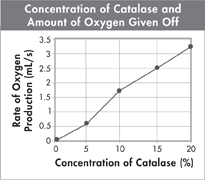Standardized Test Prep
Multiple Choice
The elements or compounds that enter into a chemical reaction are called
products.
catalysts.
active sites.
reactants.
Chemical bonds that involve the total transfer of electrons from one atom or group of atoms to another are called
covalent bonds.
ionic bonds.
hydrogen bonds.
van der Waals bonds.
Which of the following is NOT an organic molecole found in living organisms?
protein
nucleic acid
sodium chloride
lipid
Which combination of particle and charge is correct?
proton: positively charged
electron: positively charged
neutron: negatively charged
electron: no charge
In which of the following ways do isotopes of the same element differ?
in number of neutrons only
in number of protons only
in numbers of neutrons and protons
in number of neutrons and in mass
Which of the following molecoles is made up of glycerol and fatty acids?
sugars
starches
lipids
nucleic acids
Nucleotides consist of a phosphate group, a nitrogenous base, and a
fatty acid.
lipid.
5-carbon sugar.
6-carbon sugar.
Questions 8–9
The enzyme catalase speeds up the chemical reaction that changes hydrogen peroxide into oxygen and water. The amount of oxygen given off is an indication of the rate of the reaction.

Based on the graph, what can you conclude about the relationship between enzyme concentration and reaction rate?
Reaction rate decreases with increasing enzyme concentration.
Reaction rate increases with decreasing enzyme concentration.
Reaction rate increases with increasing enzyme concentration.
The variables are indirectly proportional.
Which concentration of catalase will produce the fastest reaction rate?
5%
10%
15%
20%
Open-Ended Response
List some of the properties of water that make it such a unique substance.
| Question | 1 | 2 | 3 | 4 | 5 | 6 | 7 | 8 | 9 | 10 |
|---|---|---|---|---|---|---|---|---|---|---|
| See Lesson | 2.4 | 2.1 | 2.3 | 2.1 | 2.1 | 2.3 | 2.3 | 2.4 | 2.4 | 2.2 |
Table of Contents
- Formulas and Equations
- Applying Formulas and Equations
- Mean, Median, and Mode
- Estimation
- Using Measurements in Calculations
- Effects of Measurement Errors
- Accuracy
- Precision
- Comparing Accuracy and Precision
- Significant Figures
- Calculating With Significant Figures
- Scientific Notation
- Calculating With Scientific Notation
- Dimensional Analysis
- Applying Dimensional Analysis




